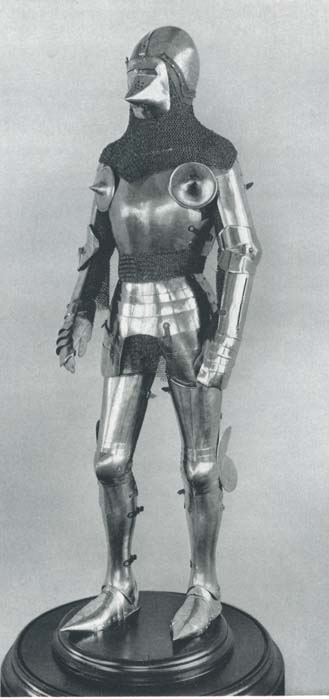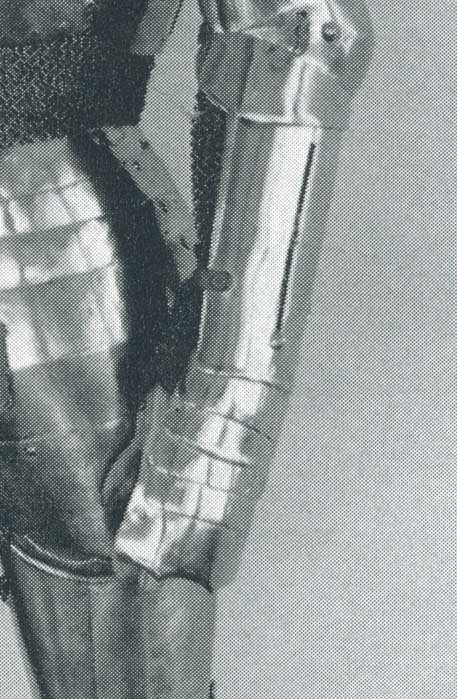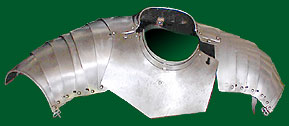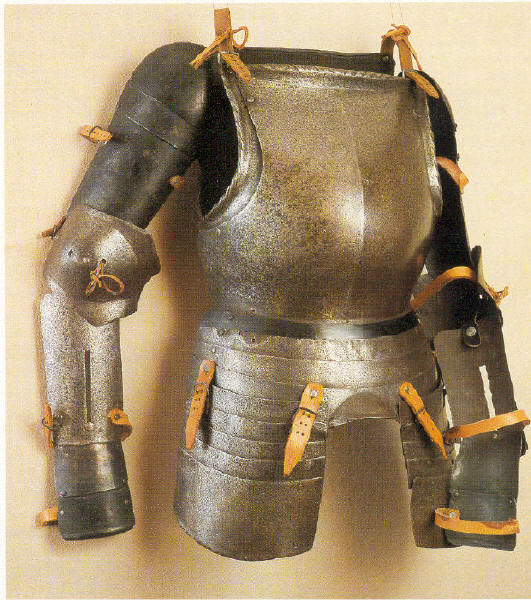| Author |
Message |
Chad Arnow
myArmoury Team


|
 Posted: Sat 20 Jan, 2007 9:22 am Post subject: Retractable mitten gauntlets Posted: Sat 20 Jan, 2007 9:22 am Post subject: Retractable mitten gauntlets |
 |
|
I was recently looking through my copy of the Catalogue of Armor The John Woodman Higgins Armory by Stephen V. Grancsay. In the book is a composite set of German armour from c. 1430. The gauntlets and vambrace are made as one unit. The lames that protect the back of the hand are attached to a rivet that slides along the length of the vambrace, retracting the hand protection.
I'm not sure I've seen anything like that before. Grancsay notes "Arm defenses of this type were worn on the left arm of archers; such archers' arm defenses have been preserved in the Museum at Bernau (near Berlin)." It looks like both arms have that and the catalogue doesn't list the arms among the restored/modern pieces.
Anyone have pictures of similar items?
 Attachment: 32.04 KB Attachment: 32.04 KB

Composite armour from c. 1430.
 Attachment: 108.19 KB Attachment: 108.19 KB

Retractable gauntlet.

ChadA
http://chadarnow.com/
|
|
    |
 |
|
Allan Senefelder
Industry Professional
|
 Posted: Sat 20 Jan, 2007 9:54 am Post subject: Posted: Sat 20 Jan, 2007 9:54 am Post subject: |
 |
|
|
Chad theres also a seperate pair of arms on display in The Higgins dating from the first part of the 16th century made this way. In A&A of the Medieval Knight theres a pic of a suit of Almain Rivets from the early 16th century with these type of arms as well. There are several woodcuts of landsknechts that I can think of that show them wearing half armours with arms done in this fashion as well.
|
|
   |
 |
|
Doug Gardner
|
 Posted: Sat 20 Jan, 2007 9:57 am Post subject: Posted: Sat 20 Jan, 2007 9:57 am Post subject: |
 |
|
Chad,
I've never heard of or seen anything like that. Of course, that doesn't really mean much. 
Interesting!
I wonder if armour of that type would be less common in museums in the US, simply because it is more likely to be munitions grade? Thoughts? It'd be interesting if there is an old European armoury with a dozen of them in a back room, somewhere!
Doug Gardner
|
|
  |
 |
Randall Moffett

|
 Posted: Sat 20 Jan, 2007 2:15 pm Post subject: Posted: Sat 20 Jan, 2007 2:15 pm Post subject: |
 |
|
The RA has one dated to early 16th across from the PAvia display that I have pictures of. I always figured them as poor man's gauntlets.
RPM
|
|
  |
 |
Richard Fay

|
 Posted: Sat 20 Jan, 2007 2:29 pm Post subject: Posted: Sat 20 Jan, 2007 2:29 pm Post subject: |
 |
|
Hello all!
Chad,
I would personally call that a bad composite armour at best, if the pieces are authentic. The arms don't really look like they go with the bascinet. The vambraces definitely look similar to Almain Rivet "splints". I think this typically dates later than 1430. Would the bascinet even be 1430? It looks earlier to me. Would a klappvisierr be as late as 1430?
I have actually seen this before; it's in Stone's glossary in the section about armour. I never noticed the sliding rivets on the vambraces, though. The image you posted is better than that in Stone.
Here's what Stone says about Almain rivets:
| George Cameron Stone wrote: |
ALMAIN RIVETS. Modern writers frequently use this name for sliding rivets, that is, rivets that slide in slots in one or both pieces that they join, thus allowing a considerable amount of flexibility. In early inventories, however, it always indicates a suit of light armor. "2000 complete harness called Almayn rivets according to a pattern in the hands of John Dawney, accounting always a salet, a gorget, a breastplate, a backplate and a pair of splints for every complete harness at 18s. the set." Payment for them was made in the King's behalf to a certain merchant of Florence, Sept. 13th, 1512. |
This is from the glossary in Arms and Armour of the Medieval Knight:
| David Edge and John Miles Paddock wrote: |
Almain Rivet. A light munition half-armour or corslet, imported from Germany in the early sixteenth century. |
This is what ffoulkes said about Almain Rivets in The Armourer and His Craft:
| Charles ffoulkes wrote: |
Perhaps the most ingenious contrivance used in making the suit of armour is the sliding rivet. This contrivance has come to be called "Almain rivet" in the modern catalogues in a sense never found in contemporary documents. In these documents the "Almain rivet" is a light half-suit of German origin, made up of breast, back, and tassets, with sometimes arm-pieces. The word "rivet" was employed in the sixteenth century for a suit of armour, for Hall uses the word frequently in his Chronicles. This word is therefore more probably derived from the same root as the French revetir, rather than from the rivets which were used in the making of the suit. Up to the sixteenth century the rivet as we know it to-day is always called an "arming nail", and it is only in the middle of the sixteenth century that we find the word rivet used as part of the armouer's stock-in-trade. These light suits were put together with sliding rivets, which have at present day received the name originally given to the whole suit. The head of the rivet is burred over and fixed in the upper plate, but the lower plate is slotted for about three-quarters of an inch, so that it will play up and down on the shankof the rivet and give more freedom of action than the fixed rivet; at the same time it will not allow the two plates to slide so far apart as will uncover the limb or body of the wearer. These sliding rivets were used to join the upper and lower portions of the breastplate which was in fashion in the last years of the fifteenth century, so as to allow a certain amount of movement for the torse backwards and forwards. They were also employed to join the taces, which needed a certain amount of play when mounting a horse or when sitting. When the "lobster-tail" cuisse superseded the taces and tassets in the late sixteenth and seventeenth centuries they were used instead of the fixed rivets for joining the lames of the cuisse.
The most ingenious arrangement of sliding rivets, however, is to be found on the brassards of the late fifteenth to the seventeenth century. |
Here's what Blair says regarding "Almain rivets" in European Armour Circa 1066 to Circa 1700:
| Claude Blair wrote: |
A special, and apparently cheaper, form of the corslet was the Almain rivet. In 1512, for example, Guido Portinari, Florentine merchant, supplied Henry VIII with
'2,000 complete harness called Almaybe ryvettes...accounting always a salet, a gorjet (i.e. a collar), a breastplate, a backplate and a pair of splints for every complete harness' at 16s. a set."
These were probably similar to a group of armours shown in 16th-century engravings of German Landesknechts and of which fragments, all of poor quality, survive in a few German armouries and at least two English ones, namely at Mendelsham Church, Suffolk, and Winchester College (now West Gate Museum,. Winchester). These all have, or once had, vambraces (splints) of the same peculiar form, protecting the outsides of the arms only, made in one with the spaulders, joined at the couters by internal leathers and usually fitted with laminated extensions over the backs of the hands instead of gauntlets. It seems not unlikely that these splints are the distinguishing feature of the Almain rivet. On many examples the hand-defense is attached to the vambrace only by a turning-pin that engages in a logitudinal slot in the lower cannon. |
There were sliding rivets in use earlier than the sixteenth century; a gauntlet featured in the appendix of Arms and Armour of the Medieval Knight of circa 1480 has a small sliding rivet at the knuckle plate, and ffoulkes mentuions their use in late fifteenth century breastplates. However, the sliding rivets on the Higgins vambrace look very similar to those on the sixteenth century Almain Rivet splint arms shown in Arms and Armour of the Medieval Knight, and sound similar to what ffoulkes describes for late 15th century "brassards". I would think that the arms are probably later than 1430.
I hope I didn't ramble too much! 
Stay safe!
"I'm going to do what the warriors of old did! I'm going to recite poetry!"
Prince Andrew of Armar
|
|
 |
 |
Dan Howard

|
 Posted: Sat 20 Jan, 2007 2:39 pm Post subject: Posted: Sat 20 Jan, 2007 2:39 pm Post subject: |
 |
|
Yes indeed. The "Almain Rivet" is a specific type of munitions plate. It has nothing to do with the sliding rivet. There is also something called an "Almain Collar" which is a plate construction that covers the neck and shoulders. I don't know whether this is the term that contemporaries used for it or whether it is a more modern term.
 Attachment: 9.58 KB Attachment: 9.58 KB

Almain Collar
|
|
  |
 |
Richard Fay

|
 Posted: Sat 20 Jan, 2007 3:17 pm Post subject: Posted: Sat 20 Jan, 2007 3:17 pm Post subject: |
 |
|
| Dan Howard wrote: | | There is also something called an "Almain Collar" which is a plate construction that covers the neck and shoulders. I don't know whether this is the term that contemporaries used for it or whether it is a more modern term. |
Dan,
Do you have any more information regarding the "Almain collar", such as date and provenance? is it contemporay with the Almain rivet light armours, or is it later? Might it be found as a part of an Almain rivet harness? Blair and Stone (quoting Portinari) mention a gorget as part of the Almain rivet harness, but there appears to be no gorget with the Almain rivet from Winchester City Museum shown in Arms and Armour of the Medieval Knight.
Just cuirious! 
By the way, for those who don't have Arms and Armour of the Medieval Knight, here's a link to a thread about munitions armour where someone posted the photo of the Almain rivet from Winchester City Museum:
http://www.myArmoury.com/talk/viewtopic.php?p=69094
The vambraces in the harness Chad posted may be of slightly better quality, but they are of similar form.
Stay safe!
"I'm going to do what the warriors of old did! I'm going to recite poetry!"
Prince Andrew of Armar
|
|
 |
 |
Dan Howard

|
 Posted: Sat 20 Jan, 2007 3:58 pm Post subject: Posted: Sat 20 Jan, 2007 3:58 pm Post subject: |
 |
|
Apparently it was worn along the Scottish borders.
I found this image of a reenactor
http://www.theborderers.info/heather.jpg
But I can't find any museum examples.
|
|
  |
 |
|
Allan Senefelder
Industry Professional
|
 Posted: Sat 20 Jan, 2007 4:26 pm Post subject: Posted: Sat 20 Jan, 2007 4:26 pm Post subject: |
 |
|
There are heaps and piles of these gorgets in Graz. If you have the book "Imperial Austria, Treasures of
Art,Arms & Armour From The State of Styria" there lots of them to be seen there. The Higgins has a set on display although the finish is much rougher.
|
|
   |
 |
Richard Fay

|
 Posted: Sat 20 Jan, 2007 4:32 pm Post subject: Posted: Sat 20 Jan, 2007 4:32 pm Post subject: |
 |
|
| Dan Howard wrote: | | Apparently it was worn along the Scottish borders. |
So, would the "Almain collar" be something possibly worn by the Border Reivers of the sixteenth century? I've read about their "lang spears" and "steill bonnets", but what about gorgets? I'm not that knowledgable about the arms of that time; it's a bit beyond my main area of interest (although I enjoyed reading Border Fury: England and Scotland at War 1296-1568 by John Sadler). Still, I would love to see if anyone could come up with a period depiction or description of a "Steel Bonnet" wearing one of these "Almain Collars".
Thanks!
Stay safe!
"I'm going to do what the warriors of old did! I'm going to recite poetry!"
Prince Andrew of Armar
|
|
 |
 |
Richard Fay

|
 Posted: Sat 20 Jan, 2007 4:43 pm Post subject: Posted: Sat 20 Jan, 2007 4:43 pm Post subject: |
 |
|
Hello again!
I found illustrations of two of these Almain collars in the appendix of Claude Blair's European Armour Circa 1066 to Circa 1700. This tends to support a possible Central European origin for at least some of these, as is suggested by what Alan said about such collars being found in Graz.
Blair shows a South-German Almain collar of circa 1550. It was from the Tower of London Armouries (II. 1 is the possible catalogue number according to Blair's caption). This one has fairly short spaulders.
The Almain collar of circa 1560 that Blair shows is possibly Saxon. It was from the Tower of London Armouries (II. 29 is the possible catalogue number according to Blair's short caption). As shown in Blair's drawing, this particular piece has bands of engraved decoration, suggesting it was a finer piece than the "Almain rivets".
I also found mention of these things in The Complete Encyclopdedia of Arms & Weapons edited by Leonid Tarrasuk and Claude Blair, under the entry for "gorget":
| Tarassuk and Blair wrote: |
A fairly common type of gorget was the Almain collar, which covered the top of the shoulders and, designed to be worn with mail sleeves, was usually provided with SPAULDERS or very small PAULDRONS. This style originated in Germany in the 1530s (hence the term, a debased form of Allemagne, French for "Germany") for light-cavalry and infantry officers officers and was worn with a straight breasted cuirass (with lowered upper edge). |
Stay safe!
"I'm going to do what the warriors of old did! I'm going to recite poetry!"
Prince Andrew of Armar
|
|
 |
 |
Chad Arnow
myArmoury Team


|
 Posted: Sat 20 Jan, 2007 8:04 pm Post subject: Posted: Sat 20 Jan, 2007 8:04 pm Post subject: |
 |
|
As exciting as this discussion is of Almain collars and gorgets and the like, I was actually curious about the kind of arm/hand protection I started the thread about.  Can we get back to that? Can we get back to that?

ChadA
http://chadarnow.com/
|
|
    |
 |
Chad Arnow
myArmoury Team


|
 Posted: Sat 20 Jan, 2007 8:06 pm Post subject: Posted: Sat 20 Jan, 2007 8:06 pm Post subject: |
 |
|
| Richard Fay wrote: |
By the way, for those who don't have Arms and Armour of the Medieval Knight, here's a link to a thread about munitions armour where someone posted the photo of the Almain rivet from Winchester City Museum:
http://www.myArmoury.com/talk/viewtopic.php?p=69094
The vambraces in the harness Chad posted may be of slightly better quality, but they are of similar form.
Stay safe! |
Good call! Here's the pic from that thread with similar arm defences:


ChadA
http://chadarnow.com/
|
|
    |
 |
Chad Arnow
myArmoury Team


|
 Posted: Sat 20 Jan, 2007 8:25 pm Post subject: Posted: Sat 20 Jan, 2007 8:25 pm Post subject: |
 |
|
| Richard Fay wrote: | Chad,
I would personally call that a bad composite armour at best, if the pieces are authentic. The arms don't really look like they go with the bascinet. The vambraces definitely look similar to Almain Rivet "splints". I think this typically dates later than 1430. Would the bascinet even be 1430? It looks earlier to me. Would a klappvisierr be as late as 1430?
|
It's both composite and contains restored/modern pieces. According to Grancsay: "The visor and helmet are genuine, but associated." The whole harness is said to be "composed of elements of several harnesses." The besagews, some of the skirt lames, the tassets and parts of the cuisses, greaves, and sabatons are "restored" (ie. not vintage). As for a snouted, klappvisier bascinet being in use around 1430, that's a tough call. The Coburg bascinet (http://www.myArmoury.com/images/features/pic_spot_basc22.jpg) is dated to 1400-1410, so they existed into the 15th century. Conventional scholarship tells us that they were out of use after the first quarter or so of the 15th century. If the helm dates to that time period, that would be pretty unusual.
It's cobbled together for sure. Perhaps that's why it left the Met (where it was displayed from 1914-1928).

ChadA
http://chadarnow.com/
|
|
    |
 |
|
Allan Senefelder
Industry Professional
|
 Posted: Sat 20 Jan, 2007 8:47 pm Post subject: Posted: Sat 20 Jan, 2007 8:47 pm Post subject: |
 |
|
|
Based on the preponderance of sighted similar examples of very late 15th or earlier 16th century date and of munitions manufacture it seems that the most likely scenarion is that a pair of these arms were used to fill out the initially shown harness. I believe arms of this sort were some times called splints?
|
|
   |
 |
Richard Fay

|
 Posted: Sun 21 Jan, 2007 9:36 am Post subject: Posted: Sun 21 Jan, 2007 9:36 am Post subject: |
 |
|
| Allan Senefelder wrote: | | Based on the preponderance of sighted similar examples of very late 15th or earlier 16th century date and of munitions manufacture it seems that the most likely scenarion is that a pair of these arms were used to fill out the initially shown harness. I believe arms of this sort were some times called splints? |
Allan,
Yes, indeed, these sorts of arms were sometimes called splints, as I mentioned in my quotes in earlier posts. I agree that the arms, if genuine, appear to be at least of late 15th or early 16th century date.
The arms seem much later than the probable date on the bascinet (late 14th-early 15th century). Maybe the bascinet is circa 1430 for it's use, but keep in mind that armours could be in use long after their date of manufacture. It could have been made ten, twenty, even thirty years earlier, especially if it was handed down. Then again, maybe it is contemporary for 1430, one of the last of a dying breed as it were.
I could be wrong, but I even notice some stylistic similarities between the couters on the composite from Higgins and the couters on the Almain rivet from Winchester City Museum. They aren't exactly the same, but the shape of the curves and the bend at the edges looks similar in both pieces. They even seem to be attached to the vambraces and rerebraces in the same fashion; there is a single prominent rivet in the centre of each couter. In the Winchester Almain rivet you can see how this attached to a leather strap that was then rivetted to the vambrace and rerebrace. Both arms are even strapped on in a similar fashion. In the close-up of the higgins arms, it even looks like there are holes for laces, just like on the Winchester couters.
I would say that the genuine pieces were from several harnesses from different dates. It looks a bit like a chimera.
"I'm going to do what the warriors of old did! I'm going to recite poetry!"
Prince Andrew of Armar
|
|
 |
 |
|
|
You cannot post new topics in this forum
You cannot reply to topics in this forum
You cannot edit your posts in this forum
You cannot delete your posts in this forum
You cannot vote in polls in this forum
You cannot attach files in this forum
You can download files in this forum
|
All contents © Copyright 2003-2024 myArmoury.com — All rights reserved
Discussion forums powered by phpBB © The phpBB Group
Switch to the Basic Low-bandwidth Version of the forum
|

